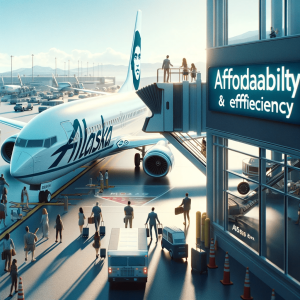Allegiant Airlines has emerged as a popular choice for budget-conscious travellers, known for its significantly lower fares compared to many of its competitors. Understanding why Allegiant Airlines so cheap requires a deep dive into its operational model, fee charges, and the steps and processes they employ to maintain affordability. This exploration offers insights into how the airline maintains its low-cost structure while still providing value to its passengers.
Operational Efficiency and Route Strategy
One of the primary reasons behind the affordability of Allegiant Airlines is its operational efficiency. Unlike larger carriers that operate on a hub-and-spoke model, Allegiant focuses on point-to-point service, primarily serving smaller, regional airports. This strategy significantly reduces operational complexities and costs associated with major hubs. By avoiding congested airports, Allegiant benefits from lower landing fees and quicker turnaround times, translating into cost savings for passengers. This approach, central to why Allegiant Airlines is so cheap, allows the airline to pass on these savings to its customers in the form of lower ticket prices.
Focused Fleet and Maintenance Costs
Allegiant operates a focused fleet, primarily comprising models like the Airbus A320. This uniformity allows for reduced costs in maintenance, training, and spare parts inventory. A streamlined fleet leads to greater operational efficiency and lower overhead costs. Moreover, Allegiant often purchases used aircraft, which are significantly cheaper than new models, further reducing capital expenditure.
Dynamic Pricing Strategy
Allegiant employs a dynamic pricing strategy that adjusts fares based on demand, route popularity, and time of booking. This flexibility allows Allegiant to offer extremely low fares during off-peak times or for less popular routes, appealing to cost-sensitive travellers. Additionally, by offering attractive initial fares, Allegiant Airlines is so cheap for those who plan and book their flights well in advance.
Ancillary Revenue and Fee Charges
A significant aspect of Allegiant's business model is its reliance on ancillary revenue – the fees and charges for additional services. While the base fare remains low, passengers pay for extras like seat selection, priority boarding, checked baggage, and in-flight refreshments. This a la carte pricing strategy allows passengers to customise their travel experience based on their budget and needs. By charging for these extras, Allegiant keeps its base fares low, making it an attractive option for travellers looking to fly on a budget.
Streamlined Processes and Customer Service
Allegiant simplifies its processes to reduce costs. For instance, they have a straightforward online booking system and a lean staffing model. By minimising overheads in areas like customer service and physical ticketing offices, the airline can keep operating costs low. The savings are then passed on to customers in the form of cheaper tickets.
Marketing and Direct Sales
Allegiant's marketing strategy focuses on direct sales through its website, avoiding the fees associated with third-party booking platforms. By selling tickets directly to consumers, Allegiant saves on commission costs typically paid to travel agents and online travel agencies. This direct-to-consumer approach is a key factor in maintaining low fare prices.
Fuel Efficiency and Environmental Practices
Fuel costs are a significant expense for any airline. Allegiant has invested in fuel-efficient aircraft and practices like single-engine taxiing to reduce fuel consumption. These measures not only contribute to a greener footprint but also lower operational costs. The savings from these environmentally friendly practices contribute to keeping Allegiant Airlines so cheap.
Conclusion
In conclusion, the reason why Allegiant Airlines is so cheap lies in its strategic operational decisions, from route selection to fleet management, and its ancillary revenue model. By focusing on cost-saving measures and efficiency, Allegiant is able to offer budget-friendly travel options without compromising on service quality. While additional fees for extras may apply, the airline provides a customizable travel experience that appeals to a wide range of travellers, especially those looking to travel affordably. Allegiant's success demonstrates the effectiveness of a low-cost airline model that prioritises efficiency, simplicity, and customer choice.
FAQS
What operational strategy does Allegiant Airlines use to offer low fares?
A- Allegiant Airlines employs a point-to-point service model, primarily serving smaller, regional airports. This strategy reduces the complexities and costs associated with major hubs, leading to lower landing fees and quicker turnaround times, which in turn helps keep fares low.
How does Allegiant Airlines' fleet contribute to its affordability?
A- Allegiant operates a focused fleet, mainly consisting of Airbus A320 aircraft. This uniformity lowers maintenance and training costs. Additionally, the airline often purchases used aircraft, which are more cost-effective than new ones, contributing to lower operational expenses.
Can you explain Allegiant Airlines' pricing strategy?
A- Allegiant uses a dynamic pricing strategy, adjusting fares based on factors like demand, route popularity, and booking timing. This allows the airline to offer very low fares during off-peak times or for less popular routes, especially for passengers who book in advance.
Why are there additional fees and charges with Allegiant Airlines?
A-While Allegiant offers low base fares, it relies on ancillary revenue from fees for additional services like seat selection, priority boarding, and checked baggage. This a la carte pricing model allows passengers to pay only for the extras they need, keeping base fares low.
How does Allegiant Airlines maintain low operating costs?
A- Allegiant simplifies its processes, like using an efficient online booking system and maintaining lean staffing. The airline also practises direct sales to avoid third-party booking fees and invests in fuel-efficient aircraft and practices. These measures help in reducing overheads and operational costs, allowing the airline to maintain affordable ticket prices.
Read more: Why is Alaska Airlines so cheap?



